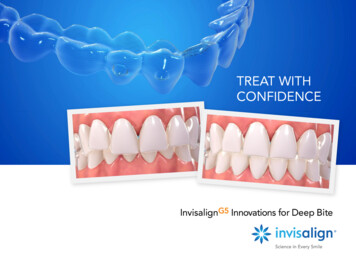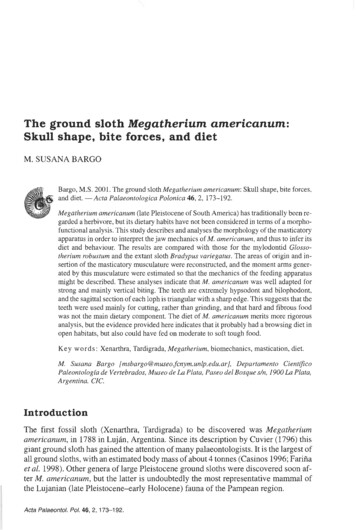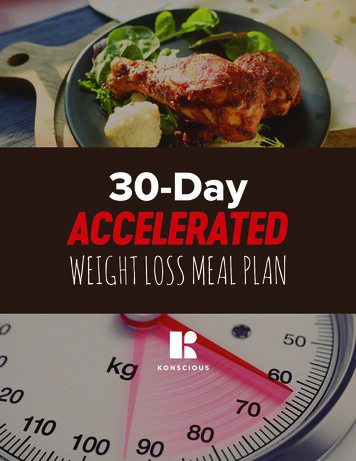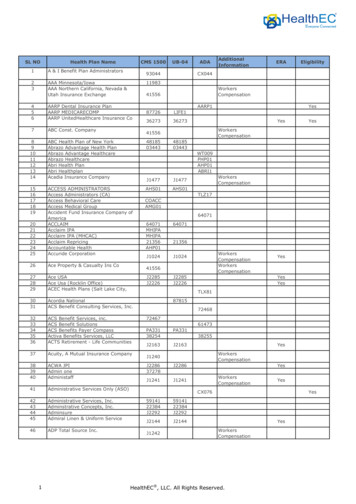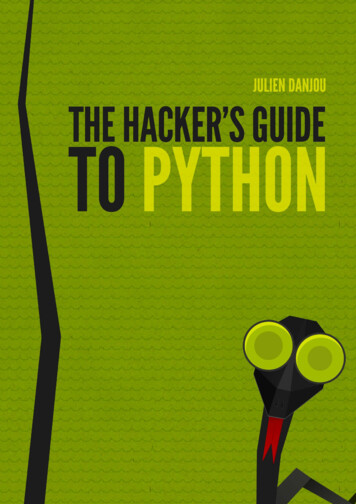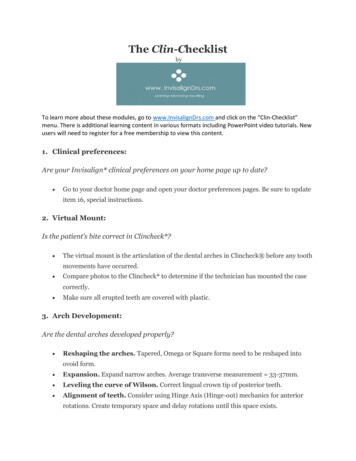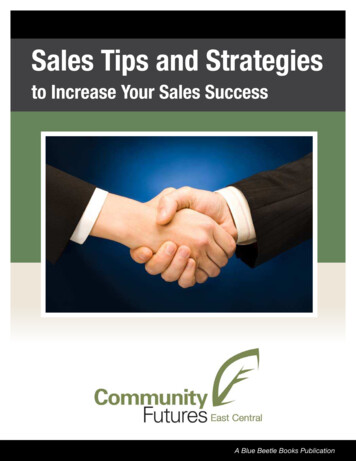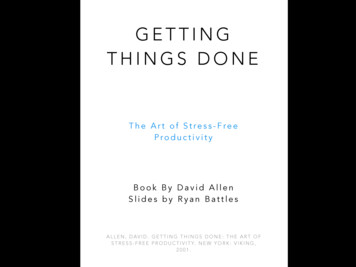
Transcription
SECOND EDITIONGetting BetterBite by BiteA survival kit for sufferersof bulimia nervosa andbinge eating disordersUlrike Schmidt, Janet Treasureand June Alexander
Getting Better Bite by BiteGetting Better Bite by Bite is an essential, authoritative and evidence-based selfhelp programme that has been used by bulimia sufferers for over 20 years. This newedition maintains the essence of the original book, while updating its content fortoday’s readers, drawing on the latest knowledge of the biology and psychology ofbulimia and its treatment.The book provides step-by-step guidance for change based on solid research.The use of everyday language, stimulating contemporary case study story-tellingand evocative illustrations in Bite by Bite provide encouragement, hope and newperspectives for all readers.This handy-sized book fills a need for easy-to-understand information aboutbulimia nervosa, a serious and prevalent eating disorder. Ulrike Schmidt and JanetTreasure are world-renowned researchers and authorities on eating disorders, andJune Alexander, a former sufferer of anorexia and bulimia, is a respected writerand internationally-known eating disorder awareness advocate. Getting BetterBite by Bite is a valuable resource – for sufferers, for their families, and for thehealth professionals and carers treating them.Ulrike Schmidt is Professor of Eating Disorders at King’s College London anda consultant psychiatrist in the Eating Disorders Unit at the Maudsley Hospital,London, UK. Her research covers all aspects of eating disorders, from causes totreatments. She has a particular interest in developing novel treatments, especiallybrief interventions that can be widely disseminated. She is the author of severalpopular self-help books and award-winning online therapy programmes.Janet Treasure, OBE, PhD, FRCP, FRCPsych, is a professor and a psychiatrist who works in research and teaching at King’s College London andas a clinician at the South London and Maudsley NHS Foundation Trust(www. thenewmaudsleyapproach.co.uk). Professor Treasure’s research interestsinclude conjoint working with patients and carers using translational research todevelop new forms of treatment.June Alexander developed anorexia nervosa at age 11, an illness that challengedand shaped her life. A love of words became a survival tool. She kept a diary
and developed a journalism career. Since 2006, June has applied lived experience and literary skills to write about eating disorders. A PhD candidate, Juneserves on Australian and international organisations, including AED, F.E.A.S.T.and NEDC. Her website: www.junealexander.com.Getting Better Bite by Bite illustrator, Elise Pacquette, who also has experiencedan eating disorder, hopes her works will help the reader to personalise their journey and to see that although obstacles may appear, when the decision to start thejourney has been made, every step is one closer to freedom.
“Countless subjects afflicted with bulimia have already benefited from using theoriginal self-help manual, one of the first written after the description of thesedisorders. The new edition retains the appeal of the original through a friendlystyle, moving case-vignettes and ingenious illustrations. Some additions enablethe inclusion of new research on the body image disturbance and on refined treatment techniques, while an extra chapter facilitates access to sources of help indifferent parts of the world. I recommend this book with full enthusiasm.”– Gerald Russell, Emeritus Professor of Psychiatry,Institute of Psychiatry, King’s College London“Ulrike Schmidt, Janet Treasure and June Alexander make an outstanding teamin this second edition of one of the foremost self-help manuals for sufferers withbulimic disorders. Drs Schmidt and Treasure are at the cutting edge in their clinical and research work in this domain, and adding June Alexander to this teamprovides this edition with an eloquent voice that represents sufferers and carers.This book is a great practical guide for those who are unwell, and also for thoseof you who are there to guide these individuals through their struggles towardrecovery – professionals, families and friends alike.”– Daniel Le Grange, PhD, Benioff UCSF Professorin Children’s Health, University of California, San Francisco, USA“Getting Better Bite by Bite is a beautifully illustrated step-by-step guide for eating disorders recovery. Through rich storytelling and concrete practical exercisesreflecting decades of collective clinical experience, this book accompanies thereader across the stepping stones to recovery. Warmth, compassion, and deep understanding flow from every page integrating perspectives of two of the most respectedeating disorder clinicians in the world and a survivor/advocate. This guide avoidsjargon and provides solid advice for anyone with an eating disorder. A rich resourcefor every library and a comforting companion for anyone contemplating recovery.”– Cynthia Bulik, PhD, FAED, Professor,Karolinska Institutet and the University of North Carolina at Chapel Hill,author of Midlife Eating Disorders and Binge Control
Getting Better Bite by BiteA survival kit for sufferers of bulimianervosa and binge eating disordersSecond editionUlrike Schmidt,Janet TreasureandJune Alexander
Second edition published 2016by Routledge2 Park Square, Milton Park, Abingdon, Oxon, OX14 4RNAnd by Routledge711 Third Avenue, New York, NY 10017First edition published 1993Routledge is an imprint of the Taylor & Francis Group, an informa business 2016 Ulrike Schmidt, Janet Treasure and June AlexanderThe right of Ulrike Schmidt, Janet Treasure and June Alexander to beidentified as authors of this work has been asserted by them in accordancewith sections 77 and 78 of the Copyright, Designs and Patents Act 1988.All rights reserved. No part of this book may be reprinted or reproduced orutilised in any form or by any electronic, mechanical, or other means, nowknown or hereafter invented, including photocopying and recording, or in anyinformation storage or retrieval system, without permission in writing fromthe publishers.Trademark notice: Product or corporate names may be trademarks orregistered trademarks, and are used only for identification and explanationwithout intent to infringe.British Library Cataloguing-in-Publication DataA catalogue record for this book is available from the British LibraryLibrary of Congress Cataloging-in-Publication DataSchmidt, Ulrike, 1955[Clinician’s guide to Getting better bit(e) by bit(e)]Getting better bite by bite : a survival kit for sufferers of bulimia nervosaand binge eating disorders / Ulrike Schmidt, Janet Treasure, and JuneAlexander. —Second edition.pages cmRevision of: Clinician’s guide to Getting better bit(e) by bit(e). c1997.1. Bulimia. I. Treasure, Janet. II. Alexander, June, 1950- III. Title.RC552.B84S36 2016616.85’263—dc232015012752ISBN: 978-1-138-79740-6 (hbk)ISBN: 978-1-138-79737-6 (pbk)ISBN: 978-1-315-75401-7 (ebk)Typeset in Times New Romanby Apex CoVantage, LLC
We thank our patients, whose stories, comments and ideas were invaluable indeveloping this book.
This page intentionally left blank
ContentsAbout the authors xiiiIntroduction A few words of caution 3What this book can and can’t do 411The way forward Do I suffer from bulimia? 6How to use this book 7First steps 9Back to the future 11Making your decision to go 13How to stage your journey 1562Tools for the journey How to facilitate change by keeping a therapeutic diary 18New skills to cope with old difficulties 22183Dieting: A health warning Beauty is in the eye of the beholder 28In the healthy weight range 29Health hazards of dieting 33How much do I need to eat? 34Achieving optimal weight and shape 34Regaining eating control 37284The black hole of the insatiable stomach Why can’t I control my eating? 43How to stop binges 43Lapses 4941
Contentsx5 Having your cake and eating it, too Facing the facts 52Why you are right to worry 52What type of weight controller are you? 53How to stop vomiting 54How to stop abusing laxatives, diuretics, medications 57516 Learning to feel good about your body How body image problems are caused and maintained 61Getting to know your body 63Looking after your body 64Other helpful strategies 64Living with your body 65597 Being fatter may be better Health risks in being overweight 68Nothing beautiful about dieting 68Avoiding the lonely trap 70Shake, shake, shake your body 70678 Relapse: Walking in circles – or not Preventing slips 77What to do if a slip occurs 78Add pleasure to your day 78779 Childhood wounds Sexual abuse 85Trying to make sense of it 86Grappling with guilt and self-blame 91After-effects of abuse 92Get a toehold on trust 92Coming to terms 938210 Food for thought Feeling like you don’t fit in 95The gloom-and-doom scenario 96When life is dreadful 96Wracked by guilt 99Please, please them 99When control gets out of control 103Defusing self-defeating thoughts 108Shoo away shame 11094
Contentsxi11 Finding your voice Learning to stand your ground 114Anything for a quiet life 115Ground rules for assertive behaviour 115Putting assertiveness into practice 11611212 The seduction of self-destruction The slippery slope of alcohol and drugs 120When to worry about alcohol intake 122Living dangerously 126Spending what you don’t have 12711913 Web of life: Parents, partners, children and friends At home with the family 129Friends 132Sexual relationships 134Children 13812914 Working to live, living to work Common work problems 14414315 The end of your journey – or not If you are still stuck 152Time to get real about you 152Recovery: An adventure in self-discovery 15315116 Where to get help and support Worldwide eating disorder advocacy organizations 156Books and other resources 160Further reading 161155Appendix 167
This page intentionally left blank
About the authorsUlrike Schmidt is professor of eating disorders at the Institute of Psychiatry,Psychology and Neurosciences at King’s College London. She is also a consultant psychiatrist in the Eating Disorders Unit at the Maudsley Hospital. Shewas a member of the NICE Eating Disorders Guidelines Development Group,chair of the Section of Eating Disorders at the Royal College of Psychiatristsand a board member of the Academy for Eating Disorders (AED). She is aCouncil member of Beat, the UK’s main eating disorders charity. She is therecipient of a 2005 NHS Award for Innovative Service Delivery, the 2009 AEDLeadership Award for Clinical, Educational and Administrative Services, the2013 KCL Supervisory Excellence Award and the 2014 Hilde Bruch Awardfor Outstanding Achievements in Eating Disorders Research and Treatment.Professor Schmidt has published some 300 peer-reviewed papers and 90 otherpublications on eating disorders, including text books, chapters, patient manuals, and web-based treatment or training packages. A key focus of her researchhas been on development of brief scalable psychological treatments for eatingdisorders.Janet Treasure, OBE, is a psychiatrist who has worked professionally with people with eating disorders for over 33 years at the Eating Disorder Unit at theSouth London and Maudsley Hospital NHS Trust, which is a leading centrein clinical management and training of eating disorders. She was chairmanof the physical treatment section of the UK NICE guideline committee. Sheis the chief medical advisor for Beat (the main UK eating disorder charity).She was awarded with a leadership for research with the Academy of EatingDisorders in 2007 and was also awarded a lifetime achievement award fromthe Academy of Eating Disorders and from Beat in 2014. She is trustee of thecharities Student Minds, Charlotte's Helix, Diabetics with Eating Disordersand the Psychiatry Research Trust and is on the scientific board of the charitiesSUCCEED, MAED – Mothers Against Eating Disorders and FEAST.June Alexander is a writer and PhD candidate. At age 11, June developed anorexia nervosa and this challenge, together with a love of writing, shaped herlife. Upon recovering from her illness at age 55 in 2006, June departed a journalism career to write books about eating disorders – combining life experience
xiv About the authorsand professionals skills to disseminate evidence-based research for healthpractitioners and mainstream readers. June serves on national and internationalmental health and advocacy organisations, including Academy of Eating Disorders, F.E.A.S.T. and the National Eating Disorders Collaboration (Australia).Her website and blog supports this advocacy work. She speaks publicly onthe theme “Hope at Every Age” and presents workshops on writing as a therapy. June is a PhD candidate in creative writing at CQUniversity, Australia,exploring how diary writing can be therapeutically applied in the treatment ofeating disorders, and is a diary-writing mentor with inpatients in a hospital eating disorders unit. June has a website at www. junealexander.com.Elise Pacquette, illustrator, gains inspiration for her work from her experienceof recovery from anorexia nervosa. She understands many of the battles alongthe journey towards recovery, including the reluctant start, the hurdles, thetemptations and the slip-ups. Having made this journey, she appreciates that itnot only took her towards recovery but also was rewarding in itself, gatheringalong the way many insights and an understanding of herself that have beeninvaluable. Elise is now married with children and, inspired by her eating disorder experience, has developed a course for 11–12 year olds to attend withtheir parents/carers about growing up and becoming independent; run as anafter-school club, this course helps parents and children to explore togetherwhat it means to grow up in today’s culture. Elise wishes all those who journeythrough this book the strength to keep going, step by step, bite by bite.
IntroductionThe important message throughout every page of Getting Better Bite by Bite isthat recovery is possible, at every age. This book does not pretend that recoveryfrom an eating disorder is easy. What this book does do is arm you with skills andknowledge to make your recovery journey as smooth and rewarding as possible.Getting Better Bite by Bite portrays what life is really like, living with bulimianervosa or binge eating disorder. (Hereafter, we will usually just use the termbulimia). Until directly affected by an eating disorder, most people’s perception ofthese illnesses is obtained from the media. The perception is almost always nothing like reality. There is nothing glamorous or desirable about bulimia or bingeeating. Much mystique remains. Misconceptions and misinformation aboundabout the causes, the health risks and the treatment. Access to treatment is difficult for many sufferers, and friends and relatives often have no idea how to help.Also, some doctors are not sympathetic or understanding, and make the personfeel their problem is self-inflicted and trivial and thereby compound the illnesscharacteristics of guilt, shame and loneliness.This book was originally written for the patients with bulimia attending theEating Disorders Clinic at the Maudsley Hospital, London. Our patients wanted
2Introductioninformation about their illness and practical advice on how to overcome theirproblems. This book contains in condensed form what we know to be the essentialingredients of cognitive-behavioural therapy (CBT), a form of therapy endorsedby the UK’s National Institute of Health and Care Excellence1 as the mosteffective treatment for bulimia. In addition, it incorporates evidence-based strategies for successfully changing problem behaviours as outlined in the NICE guidelines for Behaviour Change2.Getting Better Bite by Bite is unique in several respects. It strongly focuseson enhancing readers’ motivation and belief in their ability to change, includesstrategies for dealing with common accompanying problems and has an easy-to-readconversational style3. The first edition of Getting Better Bite by Bite, releasedin 1993, has helped many eating disorder sufferers, not only at the Maudsley butaround the world. We know this because many people wrote to us after workingthrough the book to tell us their personal recovery story and give us feedback.Many people, on reading this book, have felt empowered to tackle their eatingproblem and, beyond that, to address other difficulties in their lives, too. Somepeople – often those feeling less sure about what they want – found the book helpful in understanding their problem and gaining tools to make an informed decisionabout whether or not to enter treatment.Clinical trials using this book have shown that a significant proportion of people working through this book by themselves make a full and lasting recoveryfrom their eating disorder, and when this book is used with a few sessions of support and guidance from a therapist, it is as effective and more sustainable than amuch longer face-to-face CBT treatment4.CBT delivered by a therapist typically includes a case formulation in the formof a diagram or map showing how a person’s difficulties all “hang together”. Thiscan be very helpful, especially if it is really tailored to an individual. However,this approach does not always “hit the spot” for the person if, for example, themap is too complicated or too simple, or makes the person feel forced into anunhelpful structure. The available research evidence suggests that therapists likethese diagrams, but it is not clear how helpful or necessary such diagrams actuallyare for people in overcoming their difficulties5. We therefore decided not to putsuch a diagram into this book. Instead, we have taken a problem-led approach,with each chapter tackling an area relevant to most or particular subgroups ofpeople with bulimia or binge eating.This updated Second Edition can help you, too, on your journey to recovery. Youmust undertake this journey of change yourself, but we can be like your supportcrew, ready to help you plan and prepare and to be beside you as you travel towardsyour destination. We can provide maps and point out the dangers and pitfalls alongthe route. Importantly, we can help you find a way to overcome the inevitableobstacles. No matter how big the obstacle, we can help you find a way around itand work with you to achieve recovery. Remember, there is always a solution.You may have mixed feelings about leaving the sense of security that accompanies the familiar territory of bulimia. You know that there are severe dangerson all sides, and you may have constructed ways of ignoring or suppressing those
Introduction 3dangers. You will feel frightened about entering the new territory without thebackup of your bulimia or binge eating behaviours. This book is filled with thetravellers’ tales of people like yourself who have made the journey before you.They are here to travel with you, to keep you company and help to decrease yoursense of isolation.This book is full of clues on how to avoid the traps of self-defeating thoughtpatterns. It contains the tools you need to travel safely along the road to recovery. It shines a light on changes that you can make to replace the short-lived anddoomed-to-fail rewards that you get from your illness. Getting Better Bite by Biteoffers safe, reliable, long-lasting alternatives.Getting Better Bite by Bite also will help you to anticipate, and prepare for,obstacles and detours on the way. You may experience initial discomfort (justlike we get aches when we start a new exercise or dance routine, as latent musclegroups are brought into use), but persevere because eventually you will get pastthis stage and start to recognize and enjoy the many benefits of your new skillsand new-found strengths.Not everyone is successful at first. Setbacks and lapses commonly occur. However, always remain hopeful because you can learn from these experiences. Forsome sufferers, the change process is slow and laborious, requiring many attemptsbefore achieving freedom of self; others find the way is easier.The time taken to recover from bulimia or binge eating disorder is threemonths on average, but differs for each person. Vigilance and a high level ofself-awareness is often necessary for years afterwards to ensure your life remainsunshackled by the eating disorder.You may feel, “I can’t help myself. I have tried. My problem is too severefor this. I need someone else to take over.” However, any form of treatment canwork only when you are actively involved. The more you put in, the more youwill strengthen and empower your true sense of self. So you might as well startnow. We don’t expect that reading Getting Better Bite by Bite will make you suddenly “snap out” of your problem. However, deciding to do what it takes to stopyour chaotic eating pattern is the important first step on a journey that leads toincreased freedom and self-esteem.A few words of cautionSome people are persuaded by their families or partners to work on their problems. This book can help only if you really want to get better for yourself. Getting Better Bite by Bite can’t help if you are not ready to change, or if you justwant to change to please somebody else. To assess your readiness for undertakingthe recovery journey, go to Chapter 1; fill in your own balance sheet, and keep itclose by (in your bag or pocket) for regular consultation wherever you go.You will be asked to do a lot of hard work over the next few weeks. Even whenyou are determined to get better, there are bound to be ups and downs. The bestway to cope is to take each day as it comes and focus on living in the moment,rather than the past.
4IntroductionYou may feel tempted to “binge” on this book, that is, read it quickly and throwit in a corner, telling yourself, “this is nothing new”; “I knew all this, already”.This is certainly what the eating disorder bully wants you to think. Strive to behonest with, and listen to, your own true self. Take time to absorb and digest eachchapter slowly.What this book can and can’t doGetting Better Bite by Bite can’t cure you but can help you acquire new copingskills, so that the eating disorder no longer rules your life. This book is not aimedprimarily at helping you to understand why you developed an eating problem.Understanding the underlying causes is often difficult and happens only gradually,if at all. To know what caused the eating problem is important, but rarely helpsto change distressing eating symptoms. Getting Better Bite by Bite aims to helpyou develop new skills to ease these symptoms and to help you gain control overyour life. Once eating symptoms are addressed, underlying causes often becomeclearer and a decision will be easier regarding whether you need treatment in yourown right.Notes and references1234National Institute of Health and Care Excellence, 2004. Eating Disorders: Core Interventions in the Treatment and management of anorexia nervosa, bulimia nervosa andrelated disorders. http://guidance.nice.org.uk/CG9National Institute of Health and Care Excellence, 2014. Behaviour Change: IndividualApproaches (PH49). http://guidance.nice.org.uk/PH49We compared six widely available CBT self-help interventions for bulimia and foundthat GBBB was by far the most easy and straight forward read (Musiat, P. & Schmidt,U., 2010. Chapter in Agras, W.S. (Ed.), The Oxford Handbook of Eating Disorders.Oxford Library of Psychology).Getting Better Bite by Bite (GBBB) has been tested in seven clinical trials in the UKand internationally. These trials show that working through the book by yourself is better than doing nothing and waiting for treatment with a therapist. GBBB with guidancefrom a therapist (8 sessions) is as good as individual CBT (16–20 sessions) (Thiels, C.,et al. American Journal of Psychiatry, 1998;155:947–953; Treasure, J., et al. BritishJournal of Psychiatry, 1996;168:94–98; Treasure, J., et al. British Medical Journal,1994;308(6930):686–689). GBBB with guidance also has advantages over group CBT(Bailer, U., et al. International Journal of Eating Disorders, 2004;35:522–537) andfamily-based treatment in bulimic adolescents (Schmidt, U., et al. American Journalof Psychiatry, 2007;164:591–598). A large trial from Austria has shown that GBBBworks as well as Internet-based CBT (Wagner, G., et al. British Journal of Psychiatry,2013;202:135–141). Other researchers using a different self-help book have found thatif you start treatment using self-help for bulimia but with the option of adding othertreatments (CBT from a therapist and antidepressant medication) if necessary, youdo better in the longer term than if you have “Rolls Royce” CBT with a therapiststraight away (Mitchell, J.E., et al. British Journal of Psychiatry, 2011;198:391–397).We can only speculate why this might be, but it is likely that if you mobilise your inner
Introduction 55resources and think about what you can do yourself, this is more helpful than waitingfor someone else (a therapist) to provide the answers for you.Finally, we and others have found that working through the book and actually doingthe suggested between-session tasks leads to much better outcomes than simply skimreading it (Beintner, I., et al. Clinical Psychology Review, 2014;34(2):158–176). Thismay sound obvious but is crucial.Wilson, G.T. Behaviour Research and Therapy, 1996 Apr;34(4):295–314. Moorey, S.Journal of Cognitive and Behavioral Psychotherapies, 2010 Mar;38(2):173–184.
1The way forwardDo I suffer from bulimia?A mountainous pile of labels has emerged to describe a person who overeatsand feels distressed about it. The labels include: compulsive overeating, bulimianervosa, bulimia, binge eating disorder, bulimarexia, night eating syndrome and
The way forward7loss-of-control eating. They overlap and have an awful lot in common with eachother. Problems with overeating can occur in people of any body weight (underweight, average, and overweight). This book has been written for people who fallinto any of these categories. If feeling unsure whether any of this fits you, fill inand score the test in Table 1.1.If your severity index score is 5 points or above, you are likely to have a significant eating disorder at present.If your symptom score is 15 points or above, you have a lot of the thoughts andattitudes that go with an eating disorder and are clearly distressed by it.How to use this bookLike many people, you may have the habit of starting to read a book at the endor in the middle, perhaps flicking through the pages until a chapter title grabsyour interest. In principle, you can do that with this book, but let us explain a fewthings first: Chapters 1 to 6 are the core chapters that teach all the steps you needfor solving unhealthy eating habits. We suggest you read Chapters 1 to 6 together,but in whatever order you like. These chapters will help you decide whether youare correct in deciding that you want to get over your bulimia and are ready tostart the journey.Table 1.1 Bulimic investigatory test, Edinburgh1QuestionsScores1. Do you have a regular daily eating pattern? Yes 0, No 12. Are you a strict dieter? Yes 1, No 03. Do you feel a failure if you break your diet once? Yes 1, No 04. Do you count the calories of everything you eat, even when not on adiet? Yes 1, No 05. Do you ever fast for a whole day? Yes 1, No 06. If yes, how often is this?Have once 1; now and then 2; once a week 3;2–3 times a week 4; every second day 57. Do you do any of the following to help you lose weight?(a) Take diet pills;(b) Take diuretics (water tablets);(c) Take laxatives;(d) Make yourself vomit.Never 0; occasionally 2; once a week 3;2–3 times a week 4; daily 5; 2–3 times a day 6;5 times a day 7.Answer questions 7 (a)–(d) separately, then add them all up.8. Does your pattern of eating severely disrupt your life? Yes 1, No 09. Would you say that food dominates your life? Yes 1, No 010. Do you ever eat and eat until you are stopped by physical discomfort?Yes 1, No 011. Are there times when all you think about is food? Yes 1, No 0(Continued)
8The way forwardTable 1.1 ContinuedQuestionsScores12. Do you eat sensibly in front of others and make up in private? Yes 1,No 013. Can you always stop eating when you want to? Yes 0, No 114. Do you experience overpowering urges to eat and eat and eat? Yes 1,No 015. When you are feeling anxious, do you tend to eat a lot? Yes 1,No 016. Does the thought of becoming fat terrify you? Yes 1, No 017. Do you ever eat large amounts of food rapidly (not a meal)? Yes 1,No 018. Are you ashamed of your eating habits? Yes 1, No 019. Do you worry that you cannot control how much you eat? Yes 1,No 020. Do you turn to food for comfort? Yes 1, No 021. Are you able to leave food on the plate at the end of a meal? Yes 0,No 122. Do you deceive other people about how much you eat? Yes 1,No 023. Does how hungry you feel determine how much you eat? Yes 0,No 124. Do you ever binge on large amounts of food? Yes 1, No 025. If yes, do such binges leave you feeling miserable? Yes 1, No 026. If you do binge, is this only when you are alone? Yes 1, No 027. If you do binge, how often is this?Hardly ever 1; once a month 2; once a week 3;2–3 times a week 4; daily 5; 2–3 times a day 628. Do you go to great lengths to satisfy an urge to binge? Yes 1, No 029. If you overeat, do you feel very guilty? Yes 1, No 030. Do you ever eat in secret? Yes 1, No 031. Are your eating habits what you would consider to be normal? Yes 0,No 132. Would you consider yourself to be a compulsive eater? Yes 1, No 033. Does your weight fluctuate by more than 5 pounds in a week? Yes 1,No 0Adding up and analysing the scoresTotal for questions 6, 7 and 27. This will give you a severity index.Total for all other ques
May 27, 2014 · London, UK. Her research covers all aspects of eating disorders, from causes to treatments. She has a particular interest in developing novel treatments, especially brief interventions that can be widely disseminated. She is the author of several popular self-help bo
